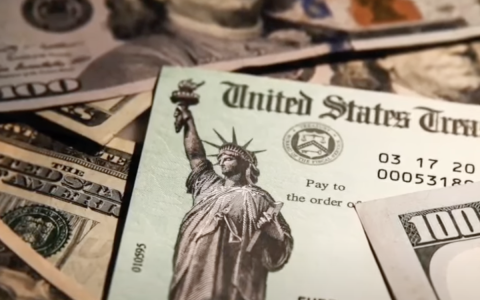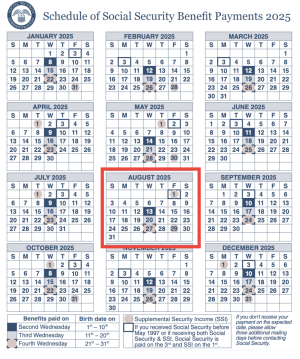Why millions of SSI recipients will see two payments this August
By
Veronica E.
- Replies 0
If you rely on Supplemental Security Income (SSI), you might notice something unusual this month—two payments instead of one.
While it may look like a bonus, it’s actually due to a simple scheduling quirk in the federal calendar.
The Social Security Administration (SSA) avoids issuing payments on weekends or holidays, so they sometimes pay early.
That’s exactly what’s happening in August, when the September benefit will arrive at the end of this month.
Here’s why it’s happening, what it means for your budget, and how to prepare.

Why two SSI payments are coming in August
SSI payments are normally sent out on the 1st of each month.
But when the 1st falls on a weekend or holiday, the SSA moves the payment to the nearest business day beforehand.
This year, September 1 falls on Labor Day, a federal holiday.
As a result, the September payment will be issued early—on Friday, August 29.
That means recipients will receive their regular August 1 payment and their early September payment during the same calendar month.
Also read: Worried about your SSI or veterans’ benefits? Here’s what the delayed payments mean for you—and what’s changing next
This isn’t extra money—it’s a timing shift
It’s important to note that this is not a bonus or an additional benefit.
The second August payment is simply your September benefit arriving early.
That means there will be no SSI deposit in September, which can catch some recipients off guard.
To avoid budgeting issues, it’s smart to treat the second payment as income for the following month and plan ahead.
Also read: 2025 rules for SSI: Are you at risk of losing your benefits?
A pattern you may have seen before
This isn’t the first time SSI payments have doubled up.
In May 2025, for example, recipients were paid twice because June 1 fell on a Saturday.
And looking ahead, it’s going to happen again.
Here’s a quick snapshot of upcoming early payment dates:

Also read: Unlocking hidden benefits: How combining SSI and SNAP in 2025 could boost your support
Who qualifies for SSI, and how much is it?
Supplemental Security Income is a federal program that helps people over age 65 or those with disabilities who have limited income and resources.
More than 7.4 million Americans receive SSI today.
To qualify, your monthly income generally must be under $2,019.
In 2025, the maximum federal SSI payment for an individual is $967 per month for eligible individuals—though some may receive less depending on other income.
Also read: Simplify your life: Discover the revolutionary system that's making SSI paperwork a breeze
Tips to manage your budget with double payments
If you receive two payments in August, the key is to plan for the gap in September.
Here are a few smart ways to manage:
Also read: Key Social Security, VA, SSI, and SSDI payment dates for 2025—mark your calendar!
More shifts are coming—stay alert
Calendar quirks will continue to affect the SSI schedule anytime the 1st of the month lands on a weekend or holiday.
These shifts can make budgeting more difficult, especially for those living on fixed incomes.
That’s why it’s important to stay informed and keep an eye on your deposit dates.
Knowing what to expect helps you prepare—and prevents any unpleasant surprises.
Read next: Are you making the most of your benefits? Some retirees qualify for all three—and don’t even realize it

If you’ve received two SSI checks in one month, how did you handle the gap in the following month? Have any budgeting tips to share with fellow readers? We’d love to hear your thoughts and experiences in the comments.
While it may look like a bonus, it’s actually due to a simple scheduling quirk in the federal calendar.
The Social Security Administration (SSA) avoids issuing payments on weekends or holidays, so they sometimes pay early.
That’s exactly what’s happening in August, when the September benefit will arrive at the end of this month.
Here’s why it’s happening, what it means for your budget, and how to prepare.

SSI recipients will receive two payments in August due to a calendar shift. Image Source: YouTube / KTNV Channel 13 Las Vegas.
Why two SSI payments are coming in August
SSI payments are normally sent out on the 1st of each month.
But when the 1st falls on a weekend or holiday, the SSA moves the payment to the nearest business day beforehand.
This year, September 1 falls on Labor Day, a federal holiday.
As a result, the September payment will be issued early—on Friday, August 29.
That means recipients will receive their regular August 1 payment and their early September payment during the same calendar month.
Also read: Worried about your SSI or veterans’ benefits? Here’s what the delayed payments mean for you—and what’s changing next
This isn’t extra money—it’s a timing shift
It’s important to note that this is not a bonus or an additional benefit.
The second August payment is simply your September benefit arriving early.
That means there will be no SSI deposit in September, which can catch some recipients off guard.
To avoid budgeting issues, it’s smart to treat the second payment as income for the following month and plan ahead.
Also read: 2025 rules for SSI: Are you at risk of losing your benefits?
A pattern you may have seen before
This isn’t the first time SSI payments have doubled up.
In May 2025, for example, recipients were paid twice because June 1 fell on a Saturday.
And looking ahead, it’s going to happen again.
Here’s a quick snapshot of upcoming early payment dates:
- Friday, August 1, 2025 – August payment
- Friday, August 29, 2025 – September payment (early)
- Wednesday, October 1, 2025 – October payment
- Friday, October 31, 2025 – November payment (early)
- Monday, December 1, 2025 – December payment
- Wednesday, December 31, 2025 – January 2026 payment (early)
- Friday, January 30, 2026 – February 2026 payment (early)
- Friday, February 27, 2026 – March 2026 payment (early)

August 2025 stands out with two SSI payment dates—August 1 and August 29—due to the September 1 holiday landing on Labor Day. Recipients won’t receive a payment in September. Image Source: Social Security Administration.
Also read: Unlocking hidden benefits: How combining SSI and SNAP in 2025 could boost your support
Who qualifies for SSI, and how much is it?
Supplemental Security Income is a federal program that helps people over age 65 or those with disabilities who have limited income and resources.
More than 7.4 million Americans receive SSI today.
To qualify, your monthly income generally must be under $2,019.
In 2025, the maximum federal SSI payment for an individual is $967 per month for eligible individuals—though some may receive less depending on other income.
Also read: Simplify your life: Discover the revolutionary system that's making SSI paperwork a breeze
Tips to manage your budget with double payments
If you receive two payments in August, the key is to plan for the gap in September.
Here are a few smart ways to manage:
- Set the second payment aside for September bills, so you don’t run short.
- Use a calendar or reminder app to track early payments and avoid surprises.
- Set up direct deposit alerts with your bank to confirm payments when they arrive.
- Ask for help from a family member or financial counselor if budgeting gets tricky.
Also read: Key Social Security, VA, SSI, and SSDI payment dates for 2025—mark your calendar!
More shifts are coming—stay alert
Calendar quirks will continue to affect the SSI schedule anytime the 1st of the month lands on a weekend or holiday.
These shifts can make budgeting more difficult, especially for those living on fixed incomes.
That’s why it’s important to stay informed and keep an eye on your deposit dates.
Knowing what to expect helps you prepare—and prevents any unpleasant surprises.
Read next: Are you making the most of your benefits? Some retirees qualify for all three—and don’t even realize it
Key Takeaways
- SSI recipients will receive two payments in August—on August 1 and August 29—due to Labor Day falling on September 1.
- The early August 29 payment is actually for September, so no SSI payment will be made that month.
- This scheduling shift happens regularly when the 1st of a month lands on a weekend or holiday.
- It’s important to plan ahead and treat the early payment as income for the next month to avoid budgeting shortfalls.
If you’ve received two SSI checks in one month, how did you handle the gap in the following month? Have any budgeting tips to share with fellow readers? We’d love to hear your thoughts and experiences in the comments.






